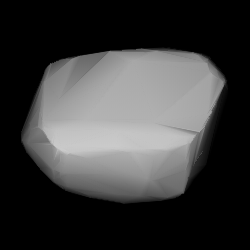Astronomy:334 Chicago
From HandWiki
Short description: Main-belt asteroid
 Modelled shape of Chicago from its lightcurve | |
| Discovery | |
|---|---|
| Discovered by | Max Wolf |
| Discovery date | 23 August 1892 |
| Designations | |
| (334) Chicago | |
| Named after | Chicago |
| 1892 L | |
| Minor planet category | Main belt |
| Adjectives | Chicagoan /ʃɪˈkɑːɡoʊən/ |
| Orbital characteristics[1] | |
| Epoch 31 July 2016 (JD 2457600.5) | |
| Uncertainty parameter 0 | |
| Observation arc | 123.39 yr (45069 d) |
| |{{{apsis}}}|helion}} | 3.98201 astronomical unit|AU (595.700 Gm) |
| |{{{apsis}}}|helion}} | 3.80814 AU (569.690 Gm) |
| 3.89507 AU (582.694 Gm) | |
| Eccentricity | 0.022319 |
| Orbital period | 7.69 yr (2807.8 d) |
| Mean anomaly | 110.236° |
| Mean motion | 0° 7m 41.567s / day |
| Inclination | 4.64130° |
| Longitude of ascending node | 130.179° |
| 148.310° | |
| Physical characteristics | |
| Dimensions | 198.77±5.7 km[1] 167.26 ± 7.27 km[2] |
| Mass | (5.06 ± 5.63) × 1018 kg[2] |
| Rotation period | 7.361 h (0.3067 d) |
| Geometric albedo | 0.041±0.013 |
| C | |
| Absolute magnitude (H) | 7.7 |
Chicago (minor planet designation: 334 Chicago) is a very large main-belt asteroid. It is classified as a C-type asteroid and is probably composed of carbonaceous material.
It was discovered by Max Wolf on August 23, 1892, in Heidelberg.
During 1999, the asteroid was observed occulting a star. The resulting chords provided a cross-section diameter estimate of 174.1 km.[3]
References
- ↑ 1.0 1.1 "334 Chicago (1892 L)". JPL Small-Body Database. NASA/Jet Propulsion Laboratory. https://ssd.jpl.nasa.gov/sbdb.cgi?sstr=334;cad=1.
- ↑ 2.0 2.1 Carry, B. (December 2012), "Density of asteroids", Planetary and Space Science 73: 98–118, doi:10.1016/j.pss.2012.03.009, Bibcode: 2012P&SS...73...98C. See Table 1.
- ↑ Shevchenko, Vasilij G.; Tedesco, Edward F. (September 2006), "Asteroid albedos deduced from stellar occultations", Icarus 184 (1): 211–220, doi:10.1016/j.icarus.2006.04.006, Bibcode: 2006Icar..184..211S.
External links
- 334 Chicago at AstDyS-2, Asteroids—Dynamic Site
- 334 Chicago at the JPL Small-Body Database
 |

